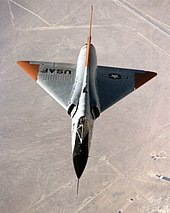Convair F-106 Delta Dart
Envisioned as an imagined "Ultimate Interceptor", it was a development of the F-102 Delta Dagger, and commenced as the F-102B prior to being redesignated by the United States Air Force (USAF).
Major differences from the F-102 included the adoption of the more powerful Pratt & Whitney J75 turbojet engine, heavily redesigned air inlets along with a variable-geometry inlet duct to suit a wide range of supersonic speeds, application of the area rule to the fuselage shaping, and a general increase in size.
During the 1960s, a competitive evaluation between the F-106 and the McDonnell Douglas F-4 Phantom II determined the latter to be marginally superior, yet the type continued to be operated for a further two decades due to extensive demand for the F-4 in other roles.
The F-106 was gradually withdrawn from USAF service during the 1980s as the arrival of newer air superiority fighters, particularly the McDonnell Douglas F-15 Eagle, had made the role of dedicated interceptors obsolete.
[4] The initial winner of this competition had been the F-102 Delta Dagger, but early versions of this aircraft had demonstrated extremely poor performance, being limited to flying at subsonic speeds and relatively low altitudes.
The resulting aircraft became the F-102A, and in spite of being considered barely suitable for its mission, the Air Force sent out a production contract in March 1954, under which the first deliveries were expected during the following year.
Continued development did not resolve problems with the engine, and in early 1955 the Air Force approved the switch to the Pratt & Whitney J75.
[12] The number of F-102As on order grew substantially beyond that which had been originally forecast, indicative of the growing importance attached to what had once been intended to be an interim or 'stop-gap' aircraft to fill in until the F-102B could be delivered.
[14] On 18 April 1956, an extended production contract for 17 F-102Bs was issued to Convair, representing substantially fewer aircraft than had been originally anticipated at this stage.
[18] During April 1957, the USAF formally rejected Convair's F-102C proposal (essentially a reengined model of the F-102) to concentrate on the more advanced F-106 program, which it had then anticipated to enter service during the following year.
[19] On 26 December 1956, the first prototype F-106, an aerodynamic test bed, performed its maiden flight from Edwards Air Force Base.
[20][18] Early flight testing around the end of 1956 and beginning of 1957 demonstrated somewhat disappointing results, having achieved less of a performance gain over the F-102 than had been anticipated.
[27][26] On 15 December 1959, Major Joseph W. Rogers set a world speed record of 1,525.96 mph (2,455.79 km/h) in a Delta Dart at 40,500 ft (12,300 m).
"[44] The arrival of the F-106 in quantity quickly led to the withdrawal of various older aircraft that were being used in the interceptor role, such as the North American F-86 Sabre and the Northrop F-89 Scorpion.
The F-106 was progressively updated in service, with improved avionics, a modified wing featuring a noticeable conical camber, an infrared search and track system, streamlined supersonic wing tanks which provided virtually no degradation to overall aircraft performance, better instrumentation and features like an inflight refuelling receptacle and an arrestor hook for landing emergencies.
[47][33] Air-to-air combat testing suggested "The Six" was a reasonable match for the F-4 Phantom II in a dogfight, with superior high-altitude turn performance and overall maneuverability (aided by the aircraft's lower wing loading).
Air combat experience over Vietnam showed the need for increased pilot visibility and the utility of a built-in gun, which had been added to the "E" variant of USAF Phantoms.
In 1972, some F-106As were upgraded in Project Six Shooter that involved fitting the F-106 with a new canopy without metal bracing which greatly improved pilot visibility.
[1] Between 1 June 1983 and 1 August 1988 the Delta Darts were incrementally retired and sent to the Military Storage and Disposition Center in Arizona.
[50][51] When the need for a high performance Full Scaled Aerial Target Drone was required, the USAF began withdrawing Delta Darts from storage.
[59][60] The Dryden Flight Research Center supported project Eclipse which sought to demonstrate the feasibility of a reusable Aerotow-launch vehicle.
[61][62] On 2 February 1970, an F-106 of the 71st Fighter-Interceptor Squadron, piloted by Captain Gary Foust, entered a flat spin over Montana.
The resulting change of balance caused the aircraft to stabilize and later belly land in a snow-covered field, suffering only minor damage.
The aircraft, promptly nicknamed "The Cornfield Bomber", was then sent back to base by rail, repaired and returned to service, and is now on display at the National Museum of the United States Air Force.










